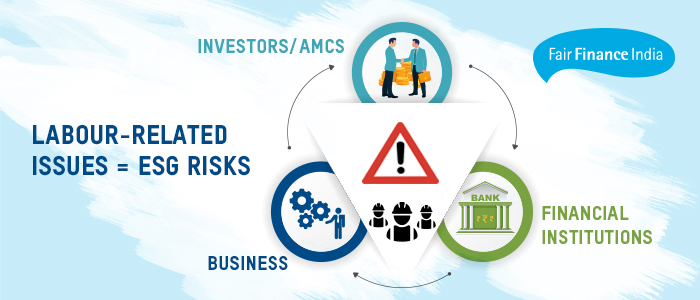
Labour and ESG issues for Businesses and Investors
04 August 2020

- by Daniel Edwin, Director at OpenSpace*
With Santosh Ganwar, Union Minister of State for Labour and Employment, proclaiming 2020 to be the ‘year of reforms’, India is all set to subsume 44 labour provisions [under the Minimum Wages Act (1948), Payment of Wages Act (1936), Payment of Bonus Act (1965), and Equal Remuneration Act (1976)] into four labour codes on wages, industrial relations, social security and occupational safety, hazards and working conditions. It is said that these four labour codes are developed with an objective to safeguard the rights of employers and the workers. The development will further have an implication on both the domestic and global investors. In this blog piece, the author outlines and explains some of the critical labour and ESG issues that are currently plaguing the supply chains in India.
Challenges of Labour
Businesses have always needed labour, and significantly so. Labour was available readily, since farms had surplus labour once agriculture became more industrialized and ‘efficient’. The skill levels needed were low, and the workers were easily replaceable. In many cases (especially in off-shored work such as call centers and ready made garment industries), it is still the case.
But in the growing and high value industries, workers are neither interchangeable nor easily replaceable. Even with re-skilling, the ‘shelf-life’ of the average worker is getting shorter. The demographic challenges of increased longevity, a lifespan of about 80 years (from 31.4 years at the time of independence), brings with it several intertwined societal ramifications. A long ‘preparatory’ phase (about 25 years of formal schooling), short worklife (about 15 to 20 years), and then a long post-work phase of about 35 to 40 years has no precedent in human history. Their high earning period of 15 to 20 years will need to sustain them and their dependent parents and children through their lengthening lives. Post-work, as opposed to retirement, means that these highly skilled workers could become whistle-blowers, activists - and also shore up the medical and leisure industries for about 40 years, or half their lives. In comparison, the average Indian life expectancy at Independence was 31.4 years. The implications of such citizens, outside the formal system, but with insider knowledge and skills, with time to mull longer term inter-generational issues, goes much beyond the present day shareholder activism, and has foundational implications for society itself.
While high skilled workers remain in demand well into their 70s, businesses struggle to hire appropriate talent. One of India’s business titans remarked that 70% of India’s engineers are unemployable. The same could be said of 90% who pass through India’s schooling system. How can high value businesses that depend on high skilled workers manage with a pool of talent that has just eight years of schooling guaranteed by the state under the right to information? Just as corporations manage their supply chain, they will need to build and invest in their skills. There will be need for more depth in the present ‘leadership pipeline’ and demands engagement with the state and schooling system rather than treating it as an externality. This depth needs to be across society to ensure that there are adequate consumers for the high quality goods and services produced. The absence of this depth, and the self-consumption of its own propaganda about the largest middle class, has caused many an investor to burn their fingers. For perspective, the highest income of 90% of Indian households is Rs 10,000 - about USD 135 - per month.
The economy with a demographic such as the one above will have different needs and consumption patterns than the present. Older people typically demand a more rule based long-term approach, and back that with their retirement funds. It shouldn’t need a pandemic to make obvious what many CSOs have been saying for long - invest in education and health, leave no one behind, we have only one earth.
The issue of informal labour - over 93% of Indian labour is in the informal sector, and a vast majority of that in precarious labour - has been the bane of Indian employment. Contractual labour has been used even earlier in the sun-rise ITES (information technology enabled services) industries such as delivery (think Dunzo, Zomato, Amazon), transport platforms (Uber, Ola, Meru). This ‘gig economy’ was stripped of its facade and its ugly underbelly exposed during the pandemic. Most of these ‘associates’ and ‘business partners’ took out personal loans to buy the tools of their trade - the taxis and the two-wheelers – and loss of income during the lockdown pushed them into bankruptcy. These gig-economy workers were among the worst hit. Financial exposure, the lack of social security, precarious working conditions, and one-sided contracts (if at all) allowed companies to leave these workers to their fate. This meant that they had no income for weeks on end, while loans’ repayments and expenses piled up. Despite the apparent ‘glamour’ of their jobs, they were little better off than their kin who were daily wage labourers in traditional industries with lack of documentation and poor business governance. Before the pandemic struck and spread across the Indian geography, the Periodic Labour Force Survey 2019 had also pointed to some of the shocking revelations around working conditions in India. These included:
- most workers were earning less than half of the minimum accepted norms, 71% did not have any written job contract, 54% were not getting paid leaves and over 57% in rural areas and nearly 80% in urban areas were working much beyond the eight-hour work day.
- Over 54% of the workers did not get paid leave and nearly half of the regular employees did not get any social security benefits, like provident fund (PF), health insurance, pension, maternity benefits etc.
- In rural areas, both self-employed and casual workers earn less than half of this minimum standard while the regular employees earn about two thirds of it.
- Casual labourers in urban areas earn about half of the minimum standard.
Instead of coming to the aid of their ‘business associates’ however, businesses have sought to profit from the pandemic, and to legitimize their extremely labour-hostile practices. Apart from the several cases of bonded labour in brick kilns being exposed, a closed door meeting of the government and builder’s associations decided to cancel trains that would enable the migrant workers - who were unpaid and uncared for weeks - to return home during the pandemic, literally making them state-sanctioned bonded labour. The regulatory capture of institutions bared its fangs again when governments of more than half a dozen states increased the permissible overtime by over 66% and increased the threshold of workers employed before the industrial unit came under regulatory provisions of the law. In some cases labour laws were abrogated, though to be fair, it was in the works long before the pandemic. Despite the sea of migrant labourers literally passing in front of their eyes, states who facilitated this ‘ease of doing business’ (despite the failure of similar interventions over the past five years) have not increased the ‘ease of doing labour’ - not even one state has made it easier for labourers to register in the labour welfare boards. Not one state has made it mandatory for registration of the employment agents in both the source and destination states. ‘Ease of doing business’ therefore is just a dog-whistle for modern day slavery.
Implications for business
Indian companies, and Indian subsidiaries of transnational companies have managed to dodge the diversity requirements of the parent company by using Indian law which does not mandate diversity, yet claim racial and other forms of discrimination and demand diversity based on the home country standards. In addition, there is serious lack of representation of women at all levels. Apart from representation, actual participation in terms of important decision making is another grey area and not much data is available in publicly disclosed documents by Indian companies. The organisations meet their gender quota, but further skewed their social ratios. Intersectionality was silently buried and caste privilege and exclusion further consolidated. This narrow social base could come to haunt any investor, who could find the goods and services produced are boycotted due to this reason. Simple re-branding will not fix a broken social order. Blithely ignoring the changing global norms, examples such as ‘glow and lovely’ stifle progress with sheer entitlement and inertia sanctioned by religious and social norms. This schizophrenia will be exposed in any social equity audit (also called diversity mapping), with consequences in the home country and developed markets.
With over 70 of the top 100 economies of the world being corporations, the line between corporate governance and public policy is blurred. While internally corporate governance should adhere to fair labour practices, clean supply chains and ethical trading, it can no longer be limited to just the boundaries of the corporation. As the UN guiding principles on business and human rights show, the social costs of the resource curse need to be factored into business models. Earlier, it was only transnational corporations or domestic ones of a certain size that had to comply. With attention to the compliance of the entire supply chain, from mining minerals to the finished electronic goods, from labour to environmental sustainability and energy cycles and human rights (a broad spectrum that includes gender rights, discrimination, anti-child labour and slavery), even the small players who supply ancillaries come under scrutiny. Orders can dry up overnight if there is a breach of standards. Contrariwise, those at the apex of the supply chain need to ensure compliance through their supply chain since they cannot afford adverse discovery disruptions either.
Implications for Investors
Investors need to be cognizant of the extremely narrow social base of the Indian workforce. Apart from an overwhelming majority of Indian company directors belonging to one particular community (Dalits and Adivasi directors make up just about 5% combined), the workforce too reflects the social exclusion. They have got away with airily stating that they do not look at the caste or religion in recruitment. However, research by the former UGC Chairman S. Thorat proves that those belonging to the socially excluded communities and Muslims are not even called for interviews, being rejected on the basis of the name on the CVs alone.
Labour is seen as an ‘external’ and as a ‘cost sink’ rather than one of the most profitable ingredients of a healthy business. Being short term vehicles, medieval corporations could shoot and scoot, and have little or no liability. Though it did bring about prosperity for the shareholders for a while, it resulted in what is euphemistically called the resource curse. The narrow social base means that Indian businesses are cesspools of patronage and nepotism, choosing to forego talent. Investors would do well to recognize this embedded inefficiency.
Building Sustainable Businesses
The lessons and the path ahead are recognized even by the most conservative, business-friendly quarters. Ratan Tata, one of India’s business stalwarts, has said that firing workers is not the solution to the pandemic. The conservative Financial Times has editorially proposed a universal basic income (UBI) and wealth tax, and to consider health as an investment not an expense.
The challenges of today need to be addressed if businesses are to survive in the emerging world. A genuine partnership between corporations, communities, consumers, and co-workers is no longer optional.
Sometimes we just need to step back and allow the angels within us to emerge.
*The author writes on behalf of Fair Finance India, a civil society initiative that seeks to strengthen the commitment of financial institutions to environmental, social and governance standards.
Thank you for submitting
Your message has succesfully been placed
